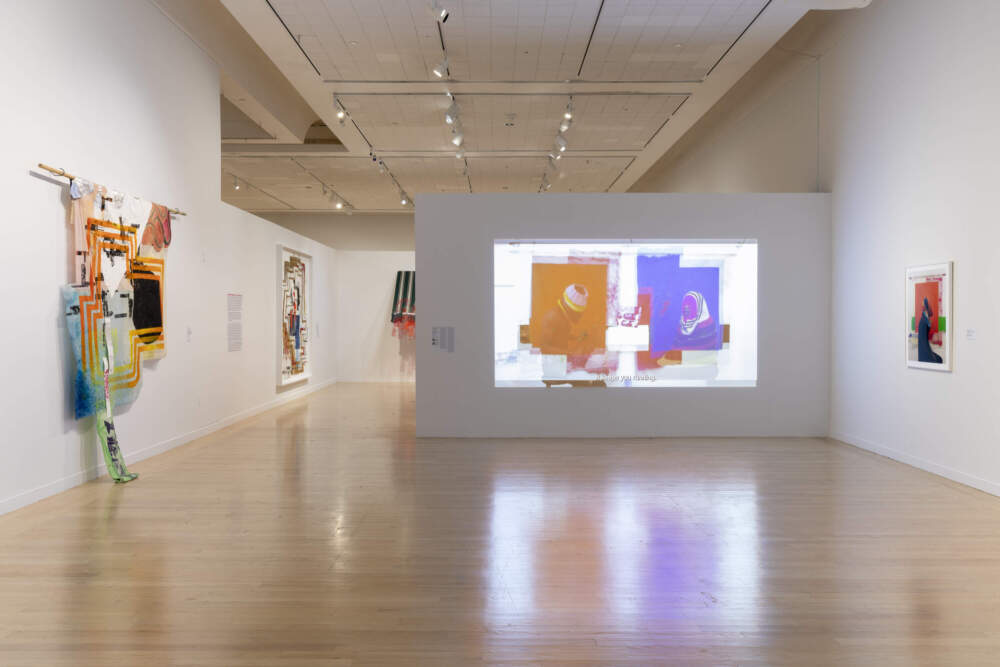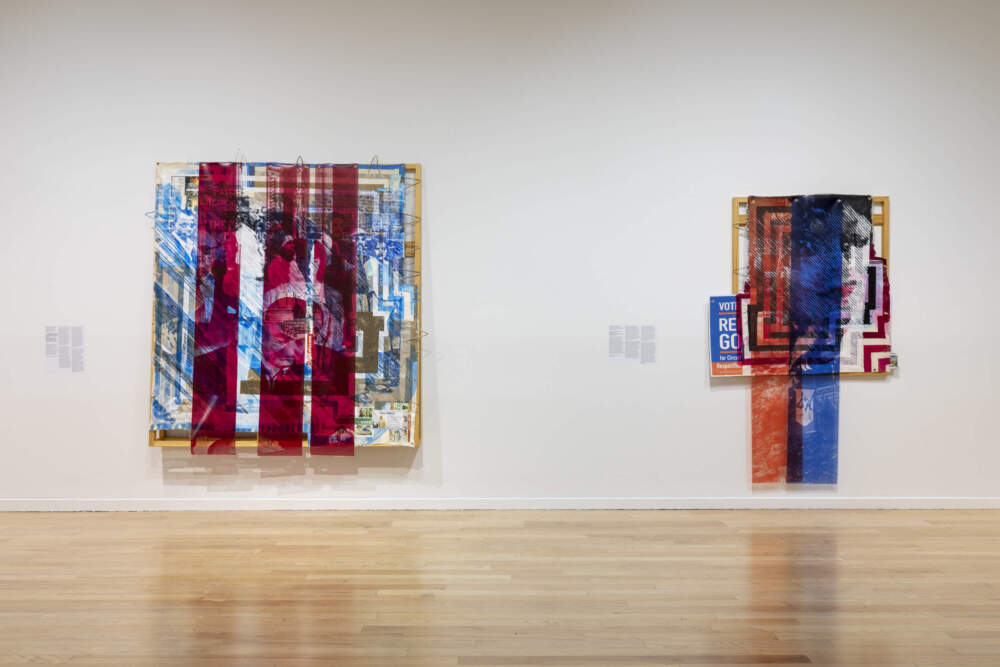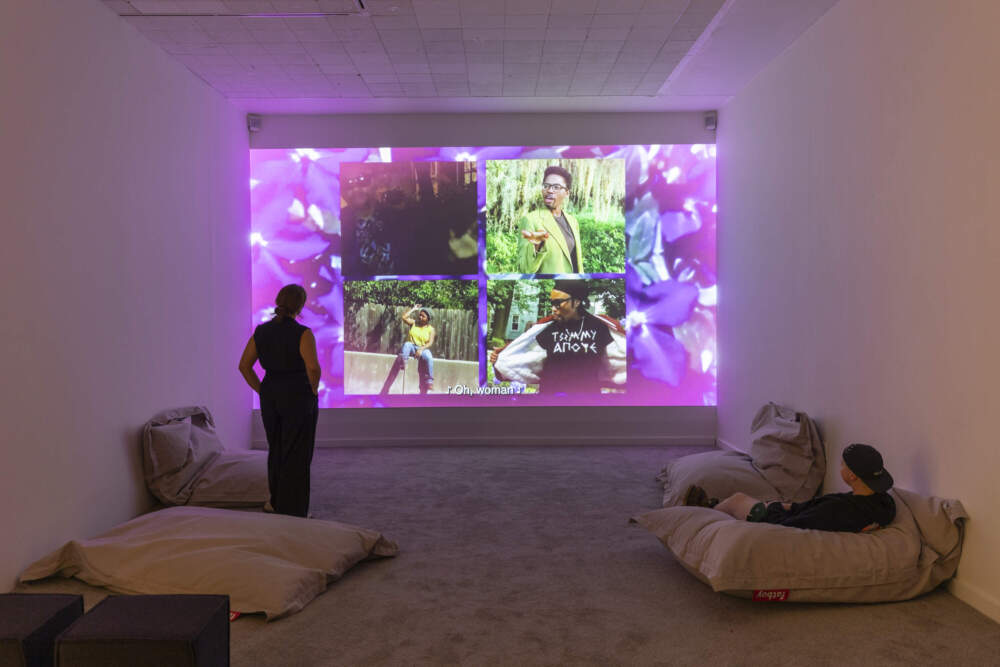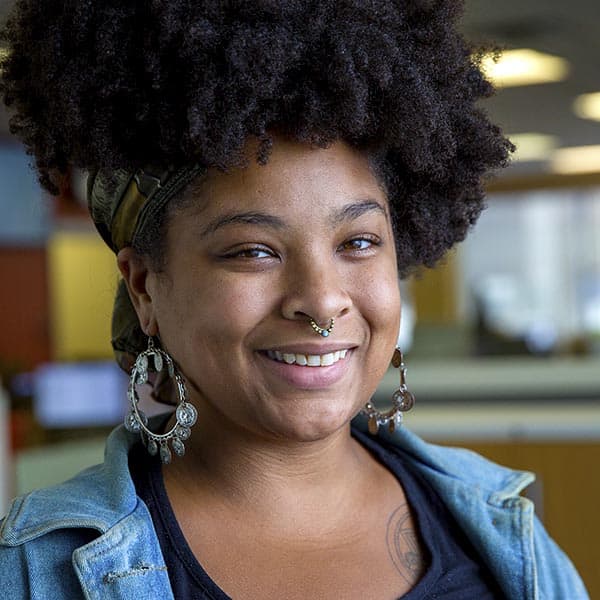Advertisement
Cambridge artist Tomashi Jackson makes a cosmic exploration of society and self

One of the first pieces immediately visible in “Tomashi Jackson: Across The Universe” at Tufts University Art Galleries is a video collage titled “Self Portrait: Tale of Two Michaels.” It practically glows as it's projected onto a gallery wall, beckoning the eye from the entrance.
Overlaid with blocks of orange and blue, two figures (wearing what Jackson calls knitted color studies) move rhythmically to “It Keeps You Runnin’” by the Doobie Brothers. A strip of green acts as a green screen, where video from Ferguson, Missouri, after the 2014 killing of Michael Brown, plays out.
With its assemblage-like gestures and moving images, the piece entangles the definitions of a painting and a video. It’s a fitting beginning to a mid-career survey of Jackson, who works in Cambridge, that collapses boundaries and categories. Many of the pieces in “Across the Universe” are foregrounded in Jackson’s research and investigation into a moment in time or a historical event. But when she talks about “Self Portrait,” the story she tells is a deeply personal one.

“When I was a kid, my mother was a night courier and she'd put me in the back of the truck,” Jackson said. Her mother loved listening to artists like Steely Dan, Aretha Franklin and the Doobie Brothers. “I have a chemical reaction to some of these sounds from this period of time.”
It’s why she compiled a playlist for herself that proved useful in 2014 when she was in her dream program at the Yale School of Art. Michael Brown had been killed and Jackson was finding it hard to get out of bed.
“The frequency of the rationalized murders of children and teenagers really started to dig at my soul,” she said.
One day, “It Keeps You Runnin’” by the Doobie Brothers came on. The song is sung by Michael McDonald, who fronted the band at the time, and also grew up in Ferguson. “This Michael with the soulful voice, that’s the Michael who lives,” Jackson said. “Then I looked down at my skin and it's like that of Michael Brown who doesn't get out of Ferguson.” McDonald penned an open letter to his fans after Brown's death, pointing out the racial inequities at play.
Jackson intertwines music with pieces throughout “Across The Universe.” It's a penchant of hers. With a taste influenced by those nights riding in the back of her mother’s truck, she said that music has become a container for her visual explorations. “It's something that I try over and over again. To let one popular song kind of poetically hold my complex emotions about our fate in the present.”
Advertisement
Archival and in-person research provides an armature that Jackson builds around using materials like halftone line images, paper bags, voting ephemera and site specific soil and dust. The survey includes video, photographs, large paintings and an outdoor mural. But putting Jackson’s work into strict categories is almost a disservice, said chief curator Dina Deitsch.
“In the world of genre between painting and sculpture, the way that Tomashi thinks about material as a concept, the two are not separate," Deitsch pointed out. "And that if there's a material choice, there's a reason for that. And that sort of has politics of its own.”

Jackson’s videos and photographs sometimes function as paintings. Meanwhile, many of her paintings are sculptural, breaching the boundaries of a regular canvas. Nearly all are intricately layered with materials and colors that overlap to create new territory of possibility. They’re apt modicums for the complicated nature of the events Jackson is exploring like Brown v. Board of Education.
In “Time and Space (1948 End of Voter Registration Line) (1965 LBJ Signs the Voting Rights Act),” painted blue and white halftone line images show Black people waiting to register to vote in 1948. Magenta vinyl hangs in three vertical strips, emphasizing an image of Pres. Lyndon B. Johnson signing the Voting Rights Act of 1965.
The use of the halftone line is a reference to Jackson’s background in printmaking. She projects halftone images and then paints them. “It allows me to use color and to cause color to interact and create new colors where they overlap through translucency,” Jackson said.
“Time and Space” is finished with a coating that includes Athens marble dust, symbolizing the birthplace of American “democracy.” Soil from Lucy Depp Park, one of the few remaining preserved Underground Railroad sites in the country, gives the surface texture — but it also connects 1948 and 1965 with a past that archival images often didn’t capture.
"You can see the relationship between using archival imagery and media imagery," Deitsch said. "There's just so much to learn by making those connections to the specific moments in history and bringing that into dialogue."
Jackson’s pieces defy and resist demarcation, demonstrating that there’s so much possibility where things overlap. Though it's clear that Jackson is adept at delving into the present and past through physical materials, it’s a statement that the mid-career survey sort of begins and ends with video. Recordings of “Tommy Tonight,” Jackson’s male R&B singer alter ego, close out the exhibition. It was a decision made by Miranda Lash, the curator of the first iteration of the show.
In one performance, Tonight lip syncs an entire Doobie Brothers album to a crowd. Jackson overlaid the song with audio taken from an interview with her mother. At the time, Jackson was taking a class on the politics of labor at Harvard’s Kennedy School of Government.

“These conversations, these papers that we were reading about informal economies, labor done without any social protection, mostly by women of color, I started to realize that that was the story of my elders,” said Jackson. Her mother told her about their family, from the Great Migration to settling in California.
Jackson recorded this personal history over long distance calls before the proliferation of recording via Skype or Zoom. The quality isn’t great, the audio clipped and hard to hear at some points. But it’s incredibly important.
“It ends up being all that I have besides, two or three voicemails, it turns out to be all that I have left of my mother's voice,” Jackson said. Her mother passed away in 2021.
While the exhibition effectively spans space and time to contextualize histories, present moments and potential futures, the intimate ties with Jackson’s own life embedded are a sort of reminder. There's potential in exploring the terrain where the personal and political intersect. Cosmic explorations and epiphanies can happen at home too.
“Across the Universe” does not claim to have a solution or answer to today’s societal inequities. Instead, it encourages a deeper and closer look at the places that "vibrate" boundaries, as Jackson calls it.
She knows that’s where galaxies of possibility live — the hope is that viewers are able to see that too.
"Tomashi Jackson: Across the Universe" is on view at Tufts Art Galleries through Dec. 8.
This segment aired on November 18, 2024.
